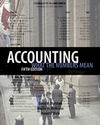 |  Accounting: What the Numbers Mean, 5/e David H. Marshall,
Millikin University
Wayne W. McManus,
International College of the Cayman Islands
Daniel F. Viele,
Webster University
The Bookkeeping Process and Transaction Analysis
Chapter 4 Learning ObjectivesAfter studying this chapter, you should understand:
1.The expansion of the basic accounting equation to include revenues and expenses. |
 |  |  | 2.How the expanded accounting equation stays in balance after every transaction. |
 |  |  | 3.How the income statement is linked to the balance sheet through owners' equity. |
 |  |  | 4.The meaning of the bookkeeping terms journal, ledger, T-account, account balance, debit, credit, and closing the books. |
 |  |  | 5.That the bookkeeping system is a mechanical adaptation of the expanded accounting equation. |
 |  |  | 6.How to analyze a transaction, prepare a journal entry, and determine the effect of a transaction on working capital. |
 |  |  | 7.The five questions of transaction analysis. |
|


 2002 McGraw-Hill Higher Education
2002 McGraw-Hill Higher Education